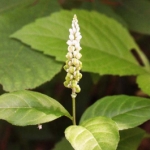| Common Name: |
Seneca Snakeroot |
| Other Names: |
Rattlesnake Root |
| Botanical Name: |
Polygala senega |
| Genus: |
Polygala |
| Family: |
Polygalaceae |
| Native Location: |
N America |
| Cultivation: |
Well-drained, moisture-retentive soil in sun or part shade. |
| Propagation: |
By seed sown in autumn. |
| Harvest: |
Roots are lifted in autumn and dried for use in decoctions, concentrated infusions, liquid extracts, powders and tinctures. |
| Height: |
45cm (18in) |
| Width: |
45cm (18in) |
| Hardiness: |
Z2-9 |
| Parts Used: |
Roots |
| Properties: |
A bitter, acrid, warming herb that has expectorant effects, and increases salivation and perspiration. |
| Medicinal Uses: |
Internally for bronchitis, mucus, asthma, and croup. Excess causes diarrhea and vomiting. Externally for pharyngitis and snakebite. |
| Bibliography: |
Encyclopedia of Herbs by Deni Brown Copyright © 1995, 2001 Dorling Kindersley Limites. Pg 326
|

